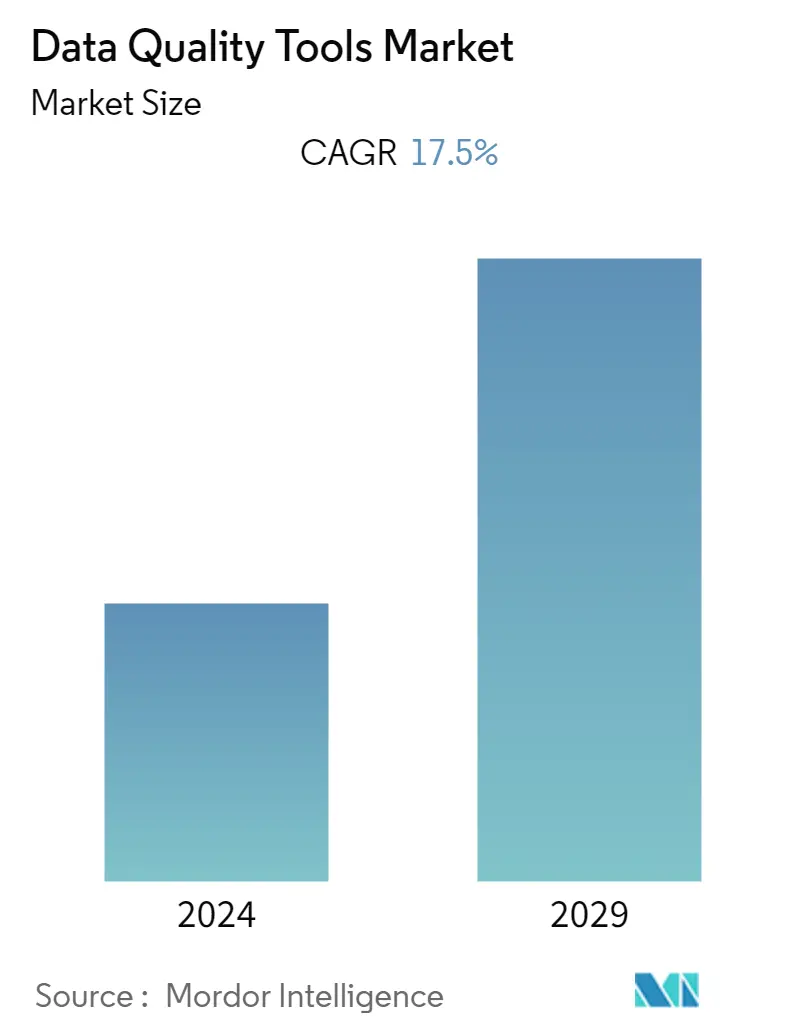Market Size of Data Quality Tools Industry

| Study Period | 2021 - 2029 |
| Base Year For Estimation | 2023 |
| CAGR | 17.50 % |
| Fastest Growing Market | Asia-Pacific |
| Largest Market | North America |
| Market Concentration | Medium |
Major Players
*Disclaimer: Major Players sorted in no particular order |
Data Quality Tools Market Analysis
The data quality tools market is expected to register a CAGR of 17.5% over the forecast period. Data quality tools generally address four primary areas: data cleansing, data integration, master data management, and metadata management. As data quality is a significant stake for large organizations, software companies are proposing increasing numbers of tools focusing on these issues. The focus of these tools is changing from specific applications (deduplication, address normalization, etc.) to a more global view that includes all aspects of data quality (profiling, rule detection, etc.).
- Furthermore, growing mobile connectivity and IoT adoption across all industries have resulted in a massive data explosion, necessitating data extraction from a variety of sources.The demand for data quality tool solutions is driven by these complex data types and formats.According to the Harvard Business Review (HBR), completing a unit of work with flawed data costs ten times more, and finding the right data quality tools has always been a challenge. One can implement a system of reliability by choosing and leveraging smart, workflow-driven, self-service data quality tools with embedded quality controls.
- Data quality tools generally address four primary areas: data cleansing, data integration, master data management, and metadata management. As data quality is a major concern for large organizations, software companies propose increasing the number of tools that address such issues. The scope of these tools is shifting from specific applications (deduplication, address normalization, etc.) to a more global perspective, integrating all areas of data quality (profiling, rule detection, etc.).
- Recent advances in mobile technology allowed users to automatically record data online, creating massive amounts of data that increased rapidly. Moreover, the capability and size of cloud computing infrastructures are continuing to accelerate, nearly beyond our abilities to leverage the opportunities provided.
- Moreover, the manufacturing sector handles multiple data streams that need to be analyzed to optimize business resources. These industries typically require handling routine, structured in-factory data, analog data, and information churned out from applications, including enterprise resource planning (ERP) systems and various process automation and control systems. Maintaining data quality would be significant for optimizing the manufacturing sector's supply chain. For instance, additive manufacturing (AM) needs tools to manage data to ensure quality, repeatability, traceability, and reliability, especially in the heavily regulated aviation and medical industries.
- Amid the COVID-19 outbreak, many companies were concerned about ensuring the quality and access to their data during this uncertain pandemic. The demand for various solutions that aid enterprises in data analytics has garnered significant attention and a positive trend in adoption. The global shift toward remote working and cloud adoption further intensified the demand for solutions that help increase work efficiency and effectiveness. Companies invested in processes and infrastructure to democratize data and enable access when the majority of the workforce works remotely as a result of the COVID-19 outbreak.
Data Quality Tools Industry Segmentation
Data quality tools are programs or applications that are used to analyze datasets and convert them into meaningful information by identifying problems and resolving them. They are used to improve the quality of datasets such as customer data, financial data, supplier data, product data, etc. These tools are used by organizations to ensure the quality of data being delivered to different business processes such as decision making, business intelligence (BI), and analytics. These tools help with different parts of data quality problems, such as enriching, monitoring, cleaning, matching, parsing, and profiling data.
The market sizes and forecasts are provided in terms of value (USD million) for all the above segments.
| By Deployment Type | |
| Cloud-based | |
| On Premise |
| By Size of the Organization | |
| Small and Medium Enterprises | |
| Large Enterprises |
| By Component | |
| Software | |
| Services |
| By End-user Vertical | |
| BFSI | |
| Government | |
| IT & Telecom | |
| Retail and E-commerce | |
| Healthcare | |
| Other End-user Industries |
| Geography | |
| North America | |
| Europe | |
| Asia-Pacific | |
| Latin America | |
| Middle East and Africa |
Data Quality Tools Market Size Summary
The data quality tools market is experiencing significant growth, driven by the increasing importance of data quality in large organizations and the rapid expansion of data generated by mobile connectivity and IoT adoption. These tools focus on key areas such as data cleansing, integration, master data management, and metadata management, evolving from specific applications to a more comprehensive approach that encompasses all aspects of data quality. The demand for these solutions is further fueled by the need to manage complex data types and formats, especially in sectors like manufacturing and healthcare, where maintaining data quality is crucial for optimizing operations and meeting regulatory standards. The COVID-19 pandemic has also accelerated the adoption of data quality tools as companies sought to ensure data accuracy and accessibility in remote working environments.
Regionally, the Asia-Pacific market is witnessing the fastest growth, driven by a surge in data-driven decision-making and the proliferation of smart cities and IoT devices. The region's start-up culture, flexible government policies, and booming eCommerce sector contribute to this expansion. In the banking and financial services industries, the abundance of data presents challenges in maintaining quality, directly impacting customer experience and operational efficiency. The competitive landscape of the data quality tools market is marked by the presence of both domestic and international companies, with major players like IBM, Oracle, and SAP focusing on comprehensive solutions to enhance market reach. Recent partnerships and acquisitions, such as Anomalo's collaboration with dbt Labs and Francisco Partners' acquisition of IBM's healthcare data assets, highlight the ongoing innovation and strategic moves within the industry.
Data Quality Tools Market Size - Table of Contents
-
1. MARKET DYNAMICS
-
1.1 Market Drivers
-
1.1.1 Increasing Use of External Data Sources Owing to Mobile Connectivity Growth
-
-
1.2 Market Restraints
-
1.2.1 Lack of information and Awareness about the Solutions Among Potential Users
-
-
-
2. MARKET SEGMENTATION
-
2.1 By Deployment Type
-
2.1.1 Cloud-based
-
2.1.2 On Premise
-
-
2.2 By Size of the Organization
-
2.2.1 Small and Medium Enterprises
-
2.2.2 Large Enterprises
-
-
2.3 By Component
-
2.3.1 Software
-
2.3.2 Services
-
-
2.4 By End-user Vertical
-
2.4.1 BFSI
-
2.4.2 Government
-
2.4.3 IT & Telecom
-
2.4.4 Retail and E-commerce
-
2.4.5 Healthcare
-
2.4.6 Other End-user Industries
-
-
2.5 Geography
-
2.5.1 North America
-
2.5.2 Europe
-
2.5.3 Asia-Pacific
-
2.5.4 Latin America
-
2.5.5 Middle East and Africa
-
-
Data Quality Tools Market Size FAQs
What is the current Data Quality Tools Market size?
The Data Quality Tools Market is projected to register a CAGR of 17.5% during the forecast period (2024-2029)
Who are the key players in Data Quality Tools Market?
IBM Corporation, Oracle Corporation, SAP SE, Informatica LLC and Talend Inc. are the major companies operating in the Data Quality Tools Market.

